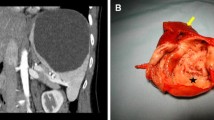Abstract
Background
It is a technical challenge to perform laparoscopic splenectomy (LS) on patients with liver cirrhosis. The purpose of this article is to share our experience with performing LS in the setting of hypersplenism secondary to liver cirrhosis.
Methods
A total of 43 LSs for hypersplenism secondary to liver cirrhosis were performed between September 2003 and January 2013. The patients studied in this series were consecutively enrolled. All of the surgeries were performed by a single surgeon. We divided our patients into two groups based on whether splenogastric ligament-entranced laparoscopic splenectomy (SLELS) was used. Data were collected retrospectively by chart review.
Results
The patients in the two groups had comparable demographic characteristics. Patients who underwent LS with SLELS (group 2) required less operating time (195.2 ± 45.8 vs. 227.7 ± 52.1 min, p = 0.042) and suffered less blood loss (160.4 ± 107.6 vs. 270.1 ± 231.2 ml, p = 0.031). No significant difference was found in terms of blood transfusion, conversion, postoperative hospital stay, and complications.
Conclusions
It is safe and feasible to perform LS on patients with hypersplenism secondary to liver cirrhosis. In the procedure of SLELS, we highlight the importance of sufficient elevation the upper pole of the spleen.


Similar content being viewed by others
References
Delaitre B, Maignien B (1991) Splenectomy by the laparoscopic approach: report of a case. Presse Med 20:2263
British Committee for Standards in Haematology General Haematology Task Force (2003) Guidelines for the investigation and management of idiopathic thrombocytopenic purpura in adults, children and in pregnancy. Br J Haematol 120:574–596
Bell RL, Reinhardt KE, Cho E et al (2005) A ten-year, single institution experience with laparoscopic splenectomy. J Soc Laparoendosc Surg 9:163–168
Silecchia G, Boru CE, Fantini A et al (2006) Laparoscopic splenectomy in the management of benign and malignant hematologic diseases. J Soc Laparoendosc Surg 10:199–205
Habermalz B, Sauerland S, Decker G et al (2008) Laparoscopic splenectomy: the clinical practice guidelines of the European Association for Endoscopic Surgery (EAES). Surg Endosc 22:821–848
Kawanaka H, Akahoshi T, Kinjo N et al (2009) Technical standardization of laparoscopic splenectomy harmonized with hand-assisted laparoscopic surgery for patients with liver cirrhosis and hypersplenism. J Hepatobiliary Pancreat Surg 16:749–757
Zhu JH, Wang YD, Ye ZY et al (2009) Laparoscopic versus open splenectomy for hypersplenism secondary to liver cirrhosis. Surg Laparosc Endosc Percutan Tech 19:258–262
Jiang XZ, Zhao SY, Luo H et al (2009) Laparoscopic and open splenectomy and azygoportal disconnection for portal hypertension. World J Gastroenterol 15:3421–3425
Wang Y, Zhan X, Zhu Y et al (2010) Laparoscopic splenectomy in portal hypertension: a single-surgeon 13-year experience. Surg Endosc 24:1164–1169
Cai YQ, Zhou J, Chen XD et al (2011) Laparoscopic splenectomy is an effective and safe intervention for hypersplenism secondary to liver cirrhosis. Surg Endosc 25:3791–3797
Tomikawa M, Hashizume M, Saku M et al (2000) Effectiveness of gastric devascularization and splenectomy for patients with gastric varices. J Am Coll Surg 191:498–503
Sugawara Y, Yamamoto J, Shimada K et al (2000) Splenectomy in patients with hepatocellular carcinoma and hypersplenism. J Am Coll Surg 190:446–450
Kercher KW, Carbonell AM, Heniford BT et al (2004) Laparoscopic splenectomy reverses thrombocytopenia in patients with hepatitis C cirrhosis and portal hypertension. J Gastrointest Surg 8:120–126
Klingler PJ, Tsiotos GG, Glaser KS et al (1999) Laparoscopic splenectomy: evolution and current status. Surg Laparosc Endosc 9:1–8
Ohta M, Nishizaki T, Matsumoto T et al (2005) Analysis of risk factors for massive intraoperative bleeding during laparoscopic splenectomy. J Hepatobiliary Pancreat Surg 12:433–437
Grahn SW, Alvarez J 3rd, Kirkwood K (2006) Trends in laparoscopic splenectomy for massive splenomegaly. Arch Surg 141:755–761 discussion 761–762
Tan M, Zheng CX, Wu ZM et al (2003) Laparoscopic splenectomy: the latest technical evaluation. World J Gastroenterol 9:1086–1089
Reso A, Brar MS, Church N et al (2010) Outcome of laparoscopic splenectomy with preoperative splenic artery embolization for massive splenomegaly. Surg Endosc 24:2008–2012
Iwase K, Higaki J, Yoon HE et al (2002) Splenic artery embolization using contour emboli before laparoscopic or laparoscopically assisted splenectomy. Surg Laparosc Endosc Percutan Tech 12:331–336
Poulin EC, Mamazza J, Schlachta CM (1998) Splenic artery embolization before laparoscopic splenectomy. An update. Surg Endosc 12:870–875
Disclosures
Yunqiang Cai, Xubao Liu, and Bing Peng have no conflicts of interest or financial ties to disclose.
Author information
Authors and Affiliations
Corresponding author
Rights and permissions
About this article
Cite this article
Cai, Y., Liu, X. & Peng, B. A Novel Method for Laparoscopic Splenectomy in the Setting of Hypersplenism Secondary to Liver Cirrhosis: Ten Years’ Experience. World J Surg 38, 2934–2939 (2014). https://doi.org/10.1007/s00268-014-2652-6
Published:
Issue Date:
DOI: https://doi.org/10.1007/s00268-014-2652-6




